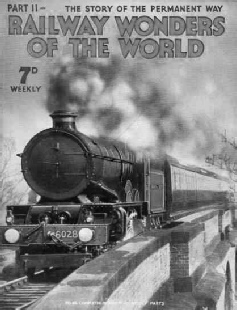
© Railway Wonders of the World 2012-


Editorial to Part 10


IT was George Bernard Shaw who said that the reasonable man adapts himself to the world, while “the unreasonable one persists in trying to adapt the world to himself. Therefore, all progress depends on the unreasonable man.” The truth of that statement has always intrigued me. It is so obvious that I am surprised it should be so often disputed, and that so many people confess an abhorrence for men who are unreasonable in their ambitions to further progress. The attitude of mind that even boasts of the belief that “what was good enough for my father is good enough for me” is either a defeatist attitude or a lazy attitude; and defeatism and laziness ought to be included among the major crimes. People who are ever ready to criticize the divine discontent are also ready enough, I notice, to derive comfort from existing things that came about only because someone, at some time or another, was discontented with things as they were.
There are many examples, and modern transport is one of them. The men who planned to ring the world with railway lines were certainly unreasonable. They were dissatisfied men. The old horse coach was not good enough for them. The steam locomotive was invented and they thought something ought to be done about it. Something was done about it, otherwise we should not now be enjoying the fruits of their labours.
THIS and the previous Parts of Railway Wonders of the World have shown us much, and future Parts will show us a good deal more. Britain may take more than an ordinary share of credit for the world’s railway development, and in Part 11, to be published next Friday, I shall begin another chapter in the series of “Railways of the Empire”. Here Australia will be reviewed in relationship to railway development. One of the most remarkable lines is that connecting Western Australia with the Eastern states -
IN the same issue my Consulting Editor, Mr. Cecil J. Allen, will tell us the story of the permanent way. Everybody who has looked from a carriage window must have wondered how the twin lines of steel, the basis of rail travel, are laid so truly and kept so perfectly. The maintenance and supervision of the permanent way are becoming more and more vital as speeds increase and “unreasonable” advances are made in every way.
But the virtue of discontent is not exclusively British, as will be found in the present number, in which is begun the story of the amazing “Direttissima” line between Florence and Bologna. On this line is the Great Apennine Tunnel, second largest in the world, and eleven and a half miles long; and seldom, if ever, has construction been fraught with so many dangers, including explosions of poisonous gases, incursions of water and outbreaks of fire. The chapter is continued into Part 11, which will also include a photogravure section showing modern stations and their ramifications as seen from the air, as well as a chapter on London’s escalators. It has been suggested that escalators are for the lazy and the aged; but the fact that their number is being rapidly increased is due to the growing problem of handling large crowds of travellers expeditiously during the rush hours.
eleven and a half miles long; and seldom, if ever, has construction been fraught with so many dangers, including explosions of poisonous gases, incursions of water and outbreaks of fire. The chapter is continued into Part 11, which will also include a photogravure section showing modern stations and their ramifications as seen from the air, as well as a chapter on London’s escalators. It has been suggested that escalators are for the lazy and the aged; but the fact that their number is being rapidly increased is due to the growing problem of handling large crowds of travellers expeditiously during the rush hours.
The editorial mail-
On this page readers will see a small reproduction of the cover for Part 11. This fine coloured illustration of a Great Western Railway engine certainly maintains the high standard achieved by its predecessors.

